|
FARM AND CROFT LAND
Introduction
Farmers and crofters are stewards of the countryside. Over successive
generations the cultivation of crops and grazing of stock has resulted in
a rich mosaic of habitats that provides food and shelter for many once
common species that are now in decline elsewhere in the UK.
Nearly 1,400 km2 or 78% of
Caithness land area is under agricultural tenure, and in addition to the
grassland, arable crops and field margins considered in this chapter,
farmers and crofters manage most of the other habitats considered in this
plan.
Biodiversity Objectives
Secure a future for upland farming and crofting that allows land managers
to use their skills and affinity with the land to the best advantage of
the environment. Implement whole farm plans that combine business and
environmental objectives. Reward good environmental management (best
practice) through better funded and more flexible agri-environment
schemes, and through the market place by securing a premium for locally
produced goods. Maintain and enhance existing areas of wildlife habitat
and encourage the creation and maintenance of wildlife corridors such as
hedges. Increase public understanding of the very real link between
agricultural activity and environmental protection.
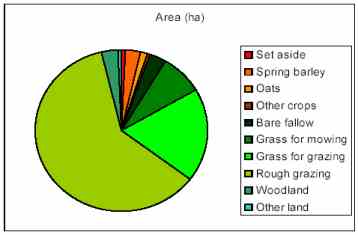
Land Use Pie Chart
(Source: June 2002 Agricultural Census)
The June 2002 Agricultural Census
states that agriculture supports 546 full-time and 1,514 part-time jobs in
Caithness. There are 1,030 crofting units, 325 farming units and 20 common
grazings in Caithness. However, the number of holdings is heavily
influenced by the fact that many farmers and crofters own or rent more
than one holding.
Grassland
Habitats and species
In the farm and croft land up straths such as at Dunbeath and Berriedale,
low intensity farming techniques supports a variety of unimproved,
herb-rich grasslands and hay meadows, important habitats in biodiversity
terms.
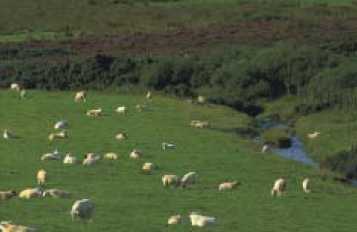
Sheep grazing, Houstry
Caithnessí rough grasslands support
good populations of brown hares and field voles, which, along with
rabbits, form an important part of the diet of hunting raptors and
wildcats. This habitat also supports high populations of insects, which
provide a food supply for birds like grey partridge and skylarks.
The sward can include a wide
variety of plants such as orchids, devilís bit-scabious, birds-foot
trefoil, and meadowsweet.
Recent survey work has shown that
Scotland is one of the last areas of Europe where grassland fungi are
reasonably widespread, and Caithness contains its share of these.
Grassland fungi are generally found on well-drained, well-leached,
unfertilised and unimproved sites that are moderately grazed.
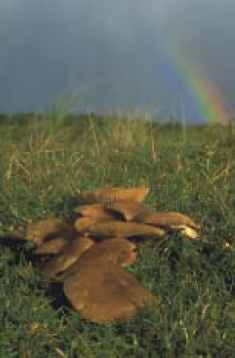
Fungi and rainbow
The UK Biodiversity Action Plan
splits rough grazing into several categories:
Lowland
dry acid grassland occurs on nutrient poor, free-draining soils
over acid rocks, sand or gravel, supporting plants such as heath bedstraw
and tormentil, and dwarf shrubs such as heather and blaeberry are also
present in small quantities.
Purple
moor grass and rush pasture occurs on shallow peaty soils. This
habitat can be species rich, wet grassland and supports a range of
invertebrate life including, slender-striped rufous and several species of
snails and flies, as well as wading birds such as snipe and curlew.
Upland
calcareous grassland is generally restricted to shallow soils
over lime-rich rocks. Despite its name, it can occur down to sea level in
exposed conditions, and arctic-alpine plants can be present.
Floodplain
grazing marsh is pasture with water filled ditches, which is
regularly flooded, grazed and occasionally cut. Wick River Marshes is an
example of this habitat type, and it is important for breeding waders such
as snipe, lapwing and curlew, and for wintering wildfowl.
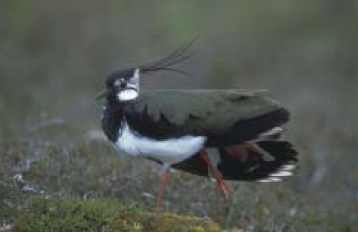
Lapwing wing stretching
Improved
grasslands and reseeds may be low in plant diversity, but in
Caithness they are important feeding areas for many wading birds such as
golden plover, lapwing, curlew and redshank. Flocks of twite and migrant
and over-wintering geese feed on many of the improved grassland fields,
and some raptors utilise these fields for hunting.
Where these grasslands have wet
patches and areas of longer vegetation, they provide greater opportunities
for corncrakes and other wildlife.
|

Habitat Map
Main issues
- With increasingly wet summers, the area of hay
has declined while silage production has increased nearly five-fold in
the last 15 years, creating increased effluent and pollution risks. The
widespread use of more aggressive grass species in reseeds to create
denser swards, along with earlier cutting of silage prevents the
successful rearing of ground-nesting birds such as corncrake, lapwing,
curlew and redshank. Where birds do attempt to breed, cutting the crop
from the centre out in one direction allows the fledglings to escape
through cover.
- Inbye croft land is increasingly left unworked.
The apportionment of common grazings leads to reseeding and fertilising
of semi-natural grassland and moorland, with an associated loss in the
biodiversity value.
- Where grasslands are species poor, it can be a
result of inappropriate management. The decline in hill cattle since the
1970s is contributing to the decline in the biodiversity of some
grasslands. Cattle grazing is often beneficial because of the
non-selective manner in which they graze and trample the ground.
Increased use of sheep dips and cattle
drenches leads to a loss in invertebrates, and there are disposal issues
with sheep dip, although regulation and the increased use of mobile
dippers has reduced the risk of pollution. The use of some broad spectrum,
anti-parasitic drugs has reduced the number and variety of insects
associated with dung, which are important as food for birds like
starlings.
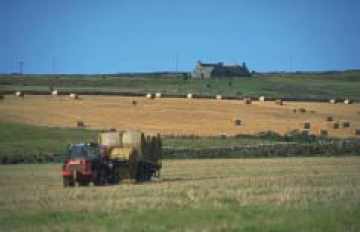
Collecting bales, Stemster
Current biodiversity projects
Some farmers and crofters are managing their grasslands through agri-environment
schemes such as the Countryside Premium Scheme, Rural Stewardship Scheme,
Organic Aid Scheme and individual management agreements on protected
sites. Under the Corncrake Scheme, the Royal Society for the Protection of
Birds gives payments for the late cutting of hay.
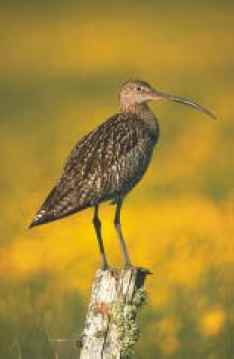
Curlew
However, many of these schemes are limited by their
overall budget, which restricts the number of farmers and crofters that
can gain entry to them, and thus limits the agri-environment works that
can be undertaken.
The Royal Society Agricultural
Benevolent Fund operates a small scheme to collect and recycle black
plastic. Lantra and the Royal
Highland Educational Trust held a training day for farmers and crofters in
giving presentations to schools.
Opportunities for action
-
Improve the biodiversity of more intensive grassland by taking up options under the
Rural
Stewardship Scheme. Retain damp areas to help
wader chicks, and areas of longer vegetation
dominated by iris or nettles to provide cover for
birds, in association with the demonstration sites
suggested in the Wetland section above, and
-
Where corncrakes are present, delay cutting of
hay until 1 August and use corncrake friendly
cutting patterns in association with RSPBís
Corncrake Initiative.
-
Participate in projects such as the Royal Society
for the Protection of Birdsí Farmer Alliance
project or Linking Environment and Farming
demonstration projects.
-
Encourage the spread of good practice through
the Caithness and Sutherland Environmental
Group.
-
Raise awareness of land management through
school links, leaflets about farm biodiversity inCaithness and greater community involvement
in agriculture.
-
Encourage every Primary School to develop a
link with a local farm or croft.
-
Improve training in land management skills
through college courses in agri-environmental
issues and skills such as species-rich grassland
and wetland management, woodland and hedge
creation, etc.
-
Encourage the British Mycological Society to
hold a field visit in Caithness.
-
Improve links with hotels and local outlets, and
promote the links between biodiversity and
locally produced beef and lamb through labelling
and positive media coverage.
-
Set up recycling trials to encourage farmers to compost green / recyclable materials from
towns
and villages onto agricultural land to reduce
landfill needs and fertiliser dependence.
|
|






